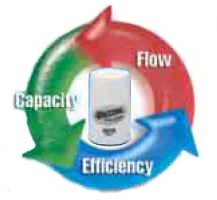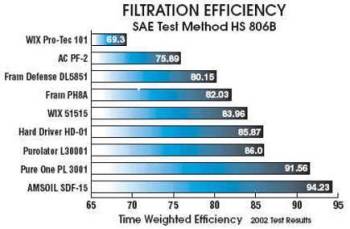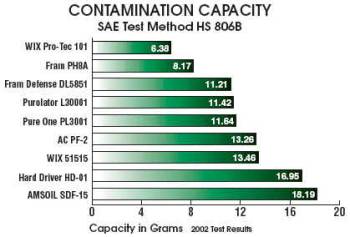The Functions of Filtration
Oil filters are expected to perform a variety of tasks. First, they must have the ability to flow an adequate volume of oil, while keeping restriction to a minimum. Second, in order to provide adequate service life, they must possess adequate particle storing capacity. Third, they must be efficient enough to remove contaminants of a given size range.

Flow
Oil is the life blood of an engine, and its constant flow is essential for proper lubrication of engine components and the prevention of friction, heat and wear. Engine components rely on the oil circulation system to deliver a steady and adequate supply of motor oil, and it is up to the oil filter to ensure fast and efficient flow through its media.
Efficiency
The removal of particles and contaminants from the oil stream is essential in keeping wear to a minimum. The smaller the size of the openings in the filtration media, the more efficient the filter in removing contaminants. However, the smaller the size of the openings, the more difficult it is for oil to flow through. This is known as the flow/efficiency compromise. High-quality filters must strike a good balance between flow and efficiency. Filtration efficiency can be measured through SAE test method HS 806B. Measuring the ability of a filter to remove a known contaminant from the oil stream, results are reported as the percent of contaminant removed over a period of time. The graph below shows the time-weighted efficiency of nine full-flow oil filters using SAE test method HS 806B. All filters are of the same size and are recommended for the same application. Test results indicate that the AMSOIL SDF-15 offers up to 36 percent greater filtration efficiency than competing oil filters.
Capacity
As filters continually remove contaminants from the oil stream, they eventually become obstructed, compromising flow and shortening the life of the filter. SAE test method HS 806B also measures an oil filterís capacity by noting the amount of contaminant it takes to increase resistance across the filtration media by a given degree. The graph below shows the filtration capacity of the same nine full-flow oil filters using SAE test method HS 806B. Test results indicate that the AMSOIL SDF-15 offers a contaminant holding capacity up to 185 percent greater than competing oil filters.
AMSOIL Super Duty Oil Filters
Most conventional oil and air filters make use of paper as the filtration media. While displaying good flow characteristics, these conventional filters are limited in their ability to catch and store particles, become obstructed quickly and require frequent replacement. AMSOIL Super Duty Oil Filters (SDF) are composed of a special cellulose, synthetic and glass blend media, providing a ready flow of oil to engine components, superior contaminant-removing efficiency and extended service life. AMSOIL SDF Oil Filters may be used for intervals of 12,500 miles or six months (whichever comes first).
 SAE HS 806B test results indicate that the AMSOIL SDF-15 offers up to 36 percent greater filtration efficiency than competing oil filters. |
 SAE HS 806B test results indicate that the AMSOIL SDF-15 offers a contaminant holding capacity up to 185 percent greater than competing oil filters. |
AMSOIL ACTION NEWS / APRIL 2003